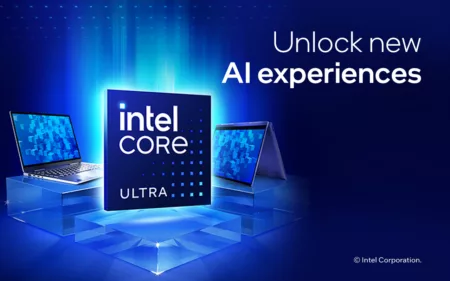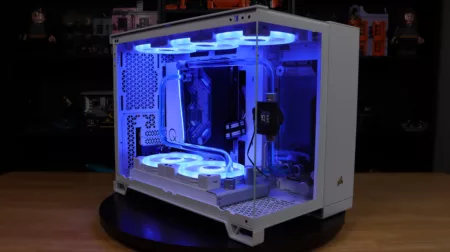AMD is way behind schedule with their own dual-GPU solution to crown the HD7xxx series of graphics cards and there’s little to no hint of it having a future release date. This puts Team Ruby without a dual-GPU flagship to compete with the venerable GTX690 from Team Green and the guys at PowerColor will not have that. PowerColor has taken on the challenge of designing and producing their own dual-GPU flagship graphics card for the extreme upper segment of the market intended for the extreme gamer and hardcore enthusiasts. PowerColor has sent us their custom-made, limited edition dual-GPU titled the HD7990 Devil13 so let’s check out if this baby is the demon-spawn it claims to be. Let’s make this extremely showy!
The extreme high-end segment of graphics cards are usually the place where nVidia and AMD showcase their fastest single card solutions. Typically of dual-GPU architecture, these products hover at the $1000 mark and are the pinnacle of their respective brand’s engineering. AMD though has been a bit delayed with their own release for the HD7xxx series even though it is known that they are working on an official design. PowerColor felt that extreme enthusiasts need their dual-GPU itch scratched and have come out with their own custom dual-GPU without help from AMD, but still uses the pre-supposed official designation of the flagship HD7990. Powered by a pair of Tahiti XT GPUs with a 925/1375Mhz Core/Memory frequency, this is basically two HD7970s on a single PCB with each GPU tied to a 6GB framebuffer at 384-bit wide bus. To step-up the card further though, PowerColor has provided a Turbo button which enables the Turbo BIOS of the card upping the core frequency to 1000Mhz. A custom-cooling solution tames the temperature of this monster and it adopts the signature color of the Devil13 line from PowerColor. Let’s check out some specs and see the card for ourselves.
Check out the official specs at PowerColor’s product page here.
CLOSER LOOK
PowerColor presents the HD7990 Devil13 in an ominous black box with very intricate detailing. No images or text aside from “Devil13” can be seen on the box.
Inside the package are a healthy bundle consisting of documentation, installation disc, display and power connectors and also a flashy screwdriver set as well as PowerColor’s own PowerJack to support the card’s immense weight as the box suggests.
And here is the card in all its glory:
The PowerColor HD7990 Devil13 is a beefy triple-slot, dual-GPU card. PowerColor uses a triple-fan custom cooler to cool the two Tahiti XT GPUs on the custom-designed PCB which measures a good 31cm in length so better check your case if it can handle such a card before purchase.
The Devil13 will require three 8-pin PCI-e power connectors. PowerColor suggests a 1200W power supply to accommodate the Devil13, we’ll check that in our later section.
The card features display output for up to 5 displays. A Turbo button is placed on the PCI bracket and swaps the active BIOS to the Turbo BIOS.
PERFORMANCE
We tested the card on different settings as you’ll see in our graph. First is the non-turbo or default mode, then Turbo mode which overclocks the core to 1Ghz and then we disable Crossfire in the Catalyst Control Panel for Single  Card mode. We used the latest drivers and profiles from AMD’s website for testing.
Test Setup
| Processor | Intel Ivy Bridge Core i7 3770K 3.5Ghz (Turbo up to 3.9Ghz) |
| Motherboards | GIGABYTE G1.Sniper M3 |
| Cooling | Corsair H100 |
| Power Supply | Silverstone Strider Plus ST65F-P + Antec EarthWatts Platinum 550W |
| Memory | Kingston HyperX Predator DDR3-2400 8GB |
| Video Cards | PowerColor HD7990 Devil13 |
| Storage | Kingston HyperX SSD 120GB |
| Operating System | Windows 7 64-bit SP1 |
Capcom’s Resident Evil spin-off title Operation: Racoon City puts us in the boots of Umbrella’s Delta Team comprising of their top operatives who get caught into the company’s twisted scheme in covering up their insidious activities.
STALKER: Call of Pripyat is an FPS title from GSC Game World. The game was released in 2010 but being a DirectX11, is still relevant in most applications. The game features a benchmarking tool to assess the user’s system, doing a 4-scenario test to fully simulate every in-game environment.
Another MMO installation in the storied Final Fantasy franchise, Final Fantasy XIV isn’t really the most hotly anticipated game but we’ll include it here since it has a nice benchmarking tool.
Sniper Elite V2 is a remake of the acclaimed original game from 2009 which puts the player in the shoes of a World War 2 sniper in the heart of Germany. With an updated game engine, the visuals are heavily improved. The game has a benchmark tool to assess how the game will perform on a preset scenario.
Resident Evil 5 sends players to uncharted regions as famed S.T.A.R.S. agent Chris Redfield.
Devil May Cry 4 show’s how Capcom still has love for PC gamers. Follow Nero and Dante as they hack, shoot and slash their way through countless enemies in style in this awesome fast-paced action game.
Battlefield 3 is one of the hottest titles of 2011 and continues to prove itself a worthy game. Based on DICE’s Frostbite Engine 2, this game’s lush details and visuals are just stunning but can really stress any modern GPU.
Unigine Heaven 3.0 is the latest iteration of the benchmarking utility for the Unigine engine. This benchmark stresses any GPU with options for DX9 to DX11 tests and boasts highly impressive tessellation scenes.
Crysis II
And here’s a FPS graph of how the card performs during an entire playthrough. We’ll eventually swap out our gaming graphs for these kinds of charts but for now we’ll ease it in. For the Devil13, we pump out Crysis II since most gamers will attribute anything performance-related to it and since drivers are optimized for it. We do a playthrough of Sudden Impact on Hardcore Settings (this is vanilla Crysis II, no high-res texture pack) as this level showcases a lot of what Crysis II can offer and torture a graphics card with.
Bottom-line:Â The HD7990 Devil13 shows incredible performance on most of our games but still we can the apparent drawback of the technology’s limitation and that is the poor scaling on some titles. Still, the Devil13 pushes through and puts itself on top of our graphs.
OVERCLOCKING
Some people just can’t live without overclocking and to satisfy your curiosity, we take the Devil13 for an OC round.
With no voltage bump, this card manages to simultaneously max out our memory and core clock slider and we feel like this card can still do so much more. Now that’s impressive!
TEMPERATURE & POWER CONSUMPTION
To measure both power consumption and heat, we stress the video card and record the peak values for heat and wattage. These are measurements taken from the wall socket so its the wattage being drawn by the entire PC. Take note that these also peak values and not the average that these cards will consume. To compute how much power is being drawn by the card, we subtract the idle temps from peak temps since we’re only stressing the GPU and we can have a rough idea how much power the card is drawing. Note that these are maximum values by a synthetic test and may not reflect real-world applications. During our gaming tests, we noted a peak of around 480-500W load consumption.
Despite the monstrous consumption the card uses, the temperatures look very good. Under the same conditions as the power load test, we measure the idle and load temps of the card using automatic fan speed. The card reaches a peak of 73*C at load with both GPU active and a lower 64*C for single GPU load. The card idles at 39*C Â at 28*C ambient temp which is also very good to see. The card manages to keep the temps at bay using only 50-65% fan speed which makes the card reasonably audible but not very loud. Bumping the fan speed to maximum will make the card very loud though.
CONCLUSION
PowerColor has certainly created one hell of a card with their HD7990 Devil13, easily demolishing everything in our charts especially in games and applications which have good Crossfire support. Much respect goes out to PowerColor for taking on the challenge in producing the first HD7990 in the market with AMD’s own solution nowhere to be found.
Basing solely on performance, this card is easy to recommend but factors like price, driver support, power draw are still considerations and here we enumerate those. First up is power consumption where the card easily reaches takes our system to around 700W peak consumption and averages around 300-400W during Crysis II and other heavy games. As we’ve no GTX690 nor other multi-GPU data for comparison, we’ll judge solely on the value itself and for our personal perspective these values are rather high. Although AMD’s ZeroCore technology does good work during idle, giving the card good temps and consumption at idle, load consumption is definitely not ideal. Next up is driver support wherein games that lack proper Crossfire support will see rather poor performance with disappointing to zero scaling at all. With AMD known for having a slower release cycles for Crossfire profiles to improve and remedy this situation, this puts the Devil13 at a position where the interested buyer should heavily consider the applications they intend to use the card with. Popular applications should see better driver support but more obscure or nVidia-friendly titles would have a bit of delay. Last up is price. As we’ve mentioned, the extreme high-end segment sees products hover around at $1000. PowerColor advices the HD7990 Devil13 to retail at approximately Php45,000 which is reserved for very financially-able gamers. The price together with the availability of the Devil13 makes it a hard acquisition.
There is no denying the supreme performance that the PowerColor HD7990 Devil13. Even with high consumption, the card manages to remain at very nice temperatures and the fans remain favorably quiet during normal operations. Overclocking also puts the card at a great advantage as we’ve already maxed out our slider yet the card isn’t showing signs of backing down. This makes the Devil13 a great choice for those chasing numbers for benchmark runs.
In closing, PowerColor offers the only extreme HD7990 in the market right now. The performance is undoubtedly remarkable, the cooler does it job well and it overclocks like a champ and as this is a limited edition card, you’ll be one of the chosen few to have the distinction of owning a unique card. Along with our Performance Award, we give the PowerColor Devil 13 a special award reserved for the likes of it.
PowerColor backs the Devil13 with an exclusive 3-year warranty.
HOT
- Extremely impressive performance on games with proper Crossfire support
- Cooler performs very well
- 3-year warranty
- Impressive packaging
- Great bundle
- Nice screwdriver set included
- BLACK and RED looks good
NOT
- Performance is support-dependent, might take a while for new games to have support
- Very heavy
- Â Triple-slot
- Noisy at full speed
- Very high power consumption






1 Comment
Super performance for they with super large display :).